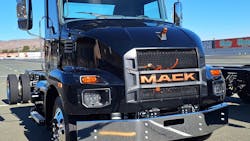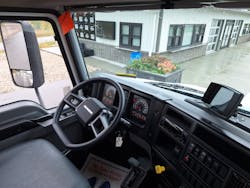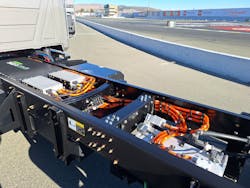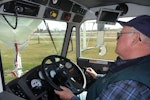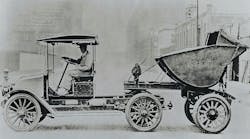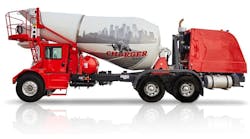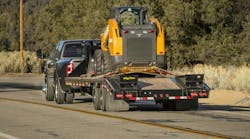Drivers like clean-burning modern diesels, with the more horsepower the better, of course. But experts say the future is electric, so drivers and their bosses will be faced with something radically new.
Several manufacturers offer electric trucks alongside their diesel versions. One is Mack, which began producing its MD Electric at its medium-duty plant in Virginia. The Class 6 and 7 diesel MD has carved out a 5%-plus market share since sales began in 2020. It’s an American product with virtually nothing borrowed from Volvo Group, Mack’s European parent.
Read also: Mack ‘Command Steer’ Adds Power to Power Steering
The MD’s engine and transmission are not Mack-made, but “vendor-supplied,” said Jonathon Randall, Mack’s president for North America, during an event staged in mid-summer at Road America. The powertrain is composed of Cummins’ B6.7 diesel with ratings up to 340 horsepower, and Allison 6-speed automatic transmissions—the same components used by most other builders of midrange trucks in the U.S.
But, Randall says, “The MD stands out because it looks like a truck, drives like a truck, and feels like a truck." He has a point. MDs have an all-business appearance. The Mack bulldog on the nose is one of the few chrome adornments. The cab sits high, giving a driver a commanding view of the road. And there’s a heavy truck feel, punctuated by the hissing sound and strong performance of air brakes that are fitted to all MDs, even the lighter Class 6 versions.
The interior includes basic instruments: big analog speedometer and tachometer; fuel, air-pressure, and engine-condition gauges; and clear and colorful pictographs that appear at startup and when necessary to call out anything troublesome with the engine or chassis systems. A fully adjustable air-ride driver’s seat is covered in cloth, and cushioned and contoured for what’s probably all-day comfort.
How does the Mack MD diesel perform?
Driving during the event was in a coned-off section of the racecourse. Modest hills, tight turns, and a single short straightaway kept speeds low but still impressed me with the vehicles’ pleasing comfort and brisk performance. I had driven a new MD on public roads two years previous, so the experience here was a refresher.
Each of the Cummins diesels had an engine brake that dragged down speed, and the Allison transmissions aided braking by downshifting to raise engine revs and boost the retarding effect. Cab interiors were quiet unless the engine fan was running. Steel cabs are from Class 8 Macks, so they are fairly roomy.
Those attributes are carried through to the MD Electric, a battery-electric truck that Mack displayed at another event, in early autumn at the Sonoma Raceway in northern California. We reporters found that space under the hood and beneath the cab’s floor are now occupied by electrical cords, electronic controllers, and batteries, and some accessories. Power-making components are in the frame behind the cab.
Read also: Alternative Fuels Help Heavy Truck Diesels Dominate
Again, Mack dismissed any idea of borrowing parts from Volvo, which is active in the e-truck business in Europe, or even from its own LE Electric, a heavy trash-collection truck, said George Fotopoulos, VP of Mack’s E Mobility division, during a pre-drive briefing.
Instead, the MD-E has a properly sized powertrain from Sea Electric, an Australian EV builder with operations in California. Its motor makes 260 continuous horsepower and is supported by two or three lithium-ion batteries from Soundon, a supplier in China. They run at 400 v. Ranges are 140 or 230 miles, enough for the vast majority of routes that midrange trucks cover, Fotopoulos said.
The E models have the same cabs, chassis, and Meritor axles used in diesel models, plus suspensions, all sized for Class 6 or 7 loadings. The motor is placed ahead of the axle differential.
How does the Mack MD electric perform?
Two MD Electric chassis were available for brief drives around the raceway’s hilly, curvy road course to show off their power and ease of driving. The chassis had no bodies or loads, which allowed close inspections of the electric components mounted between frame rails, but obviously limited realistic driving impressions.
Still, it was clear from the one I drove that an MD Electric is quick and quiet. That’s true of most e-trucks, as an electric motor makes strong torque right from the start, and it whirs rather than rumbles. A diesel has to rev up to develop its maximum power and torque, and it makes noise doing it. That drowns out most rattles and squeaks that the driver will now hear in an electric truck. This MD-E’s cab did rattle and squeak a little, which might or might not bother drivers.
The MD-E seemed to handle about the same as the diesel versions with bodies that I drove at the previous event. Rearward mounting of the motor, battery, and controllers put weight on the otherwise unladen rear axle, so lack of a body was not as obvious. An MD-E has no transmission, so the motor winds out from zero to 70 mph, according to Mack’s specs. It drives through a short propeller shaft to a standard differential housing 5.73:1 gears. I managed to reach about 45 mph on a straightaway before slowing for a turn.
Read also: Sustainability is More than a Buzzword
Of course, the E’s instruments are somewhat different. There are no engine condition gauges, and the diesel’s tachometer is replaced by a big dial that shows how much battery energy is either being consumed or replaced during braking or regeneration. A selector offers push buttons for Drive, Neutral, and Reverse.
I frequently pressed on the brake pedal or just backed off from the accelerator while approaching curves and turns and watched the needle swing to the right, indicating charging. Three regen levels can be set by a twist switch on a stalk protruding from the steering column. Retarding at Level 3 is strong and should save a lot of wear on brake linings.
The electricity to power e-trucks will likely come from “green” sources such as wind and solar. Early adopters are now finding that it takes much planning and considerable time to set up a charging infrastructure, as well as lots of money to buy the equipment. Federal tax breaks and state and local grants are available in many areas, however, making an acceptable business case for electric trucks. And Mack has set up an ElectriFi program to finance everything.
Still to be learned are long-range maintenance implications and factors such as resale values. But if this really is the future, today’s electric trucks will prove their worth while delivering clean airtheir primary point.
